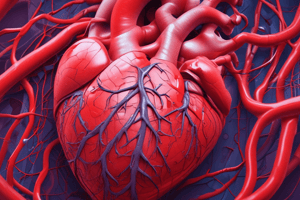Podcast
Questions and Answers
What is the primary cause of ischemic heart disease?
What is the primary cause of ischemic heart disease?
- Structural abnormalities at birth
- Buildup of plaques in coronary arteries (correct)
- Infection of the heart muscle
- High blood pressure in the lungs
Which type of angina occurs unpredictably and may occur at rest?
Which type of angina occurs unpredictably and may occur at rest?
- Stable angina
- Unstable angina (correct)
- Variant angina
- Nocturnal angina
What symptom is most commonly associated with congenital heart defects?
What symptom is most commonly associated with congenital heart defects?
- Shortness of breath only during exertion
- Chest pain
- Irregular heartbeat
- Cyanosis (correct)
Which type of cardiomyopathy is characterized by thickened heart muscle obstructing blood flow?
Which type of cardiomyopathy is characterized by thickened heart muscle obstructing blood flow?
How is unstable angina different from stable angina?
How is unstable angina different from stable angina?
What is a common risk factor for ischemic heart disease?
What is a common risk factor for ischemic heart disease?
Which test is typically used to diagnose congenital heart defects in fetuses?
Which test is typically used to diagnose congenital heart defects in fetuses?
What is a symptom of restrictive cardiomyopathy?
What is a symptom of restrictive cardiomyopathy?
Flashcards are hidden until you start studying
Study Notes
Ischemic Heart Disease (IHD)
- Definition: A condition characterized by reduced blood flow to the heart muscle, often due to coronary artery disease.
- Causes:
- Atherosclerosis: Buildup of plaques in coronary arteries.
- Thrombosis: Blood clots that obstruct blood flow.
- Symptoms:
- Angina pectoris: Chest pain or discomfort.
- Shortness of breath.
- Fatigue during exertion.
- Types:
- Stable angina: Predictable, occurs with exertion, relieved by rest.
- Unstable angina: Unpredictable, occurs at rest, may precede a heart attack.
- Myocardial infarction (heart attack): Complete obstruction leading to necrosis of heart tissue.
- Risk Factors:
- Smoking, hypertension, diabetes, high cholesterol, sedentary lifestyle, and family history.
Congenital Heart Defects (CHD)
- Definition: Structural abnormalities of the heart present at birth.
- Types:
- Acyanotic defects: Do not typically cause cyanosis (e.g., septal defects, coarctation of the aorta).
- Cyanotic defects: Cause oxygen-poor blood to flow to the body (e.g., tetralogy of Fallot, transposition of the great arteries).
- Symptoms:
- Cyanosis (bluish skin), shortness of breath, fatigue, poor weight gain, and heart murmur.
- Diagnosis:
- Fetal echocardiogram, chest X-ray, ECG, and echocardiography postnatally.
- Treatment:
- Surgical interventions, catheter-based procedures, and medication management.
Cardiomyopathy
- Definition: A group of diseases that affect the heart muscle, impairing its ability to pump blood.
- Types:
- Dilated cardiomyopathy: Enlarged heart chambers, decreased contractility.
- Hypertrophic cardiomyopathy: Thickened heart muscle, obstructs blood flow.
- Restrictive cardiomyopathy: Stiff heart muscle, limits filling.
- Symptoms:
- Symptoms may include fatigue, shortness of breath, swelling in legs/ankles/feet, and irregular heartbeats.
- Risk Factors:
- Genetic predisposition, previous heart damage (e.g., from heart attack), hypertension, and certain infections or toxins.
- Diagnosis:
- Physical examination, ECG, echocardiography, MRI, and biopsy.
- Treatment:
- Medications (e.g., ACE inhibitors, beta-blockers), lifestyle changes, and possibly heart transplant in severe cases.
Ischemic Heart Disease (IHD)
- Characterized by diminished blood flow to the heart muscle, primarily due to coronary artery disease.
- Atherosclerosis involves plaque accumulation in coronary arteries, leading to narrowing and reduced blood supply.
- Thrombosis refers to blood clots that can block coronary arteries, exacerbating ischemia.
- Common symptoms include:
- Angina pectoris: chest pain or discomfort, signaling inadequate blood supply.
- Shortness of breath, especially during exertion.
- Fatigue or unusual tiredness during physical activities.
- Types of angina:
- Stable angina is predictable, triggered by exertion, and alleviated by rest.
- Unstable angina occurs unpredictably, at rest, and may herald a heart attack.
- Myocardial infarction, or heart attack, results from total blockage, causing tissue death.
- Major risk factors include:
- Smoking and hypertension boost chances significantly.
- Diabetes, high cholesterol, sedentary lifestyle, and family history also contribute.
Congenital Heart Defects (CHD)
- Structural heart problems that are present at birth, impacting blood flow.
- Two main types of defects:
- Acyanotic defects do not usually cause cyanosis; examples include septal defects and coarctation of the aorta.
- Cyanotic defects involve inadequate oxygen-rich blood; examples include tetralogy of Fallot and transposition of the great arteries.
- Symptoms to note:
- Cyanosis, a bluish discoloration of the skin indicating low oxygen.
- Shortness of breath, feelings of fatigue, poor growth in children, and presence of heart murmurs.
- Diagnostic methods include:
- Fetal echocardiograms, chest X-rays, ECGs, and echocardiography after birth.
- Treatment options may encompass:
- Surgical procedures, catheter-based interventions, and management with medication.
Cardiomyopathy
- A collection of diseases harming the heart muscle's ability to effectively pump blood.
- Types of cardiomyopathy:
- Dilated cardiomyopathy leads to enlarged heart chambers and reduced contractile function.
- Hypertrophic cardiomyopathy features thickened heart muscles, which can obstruct blood flow.
- Restrictive cardiomyopathy presents with stiff heart muscle, limiting its fill capacity.
- Symptoms experienced include:
- Fatigue and breathlessness, particularly during activity.
- Swelling in legs, ankles, and feet, indicating fluid retention.
- Irregular heartbeats which can signal underlying issues.
- Key risk factors include:
- Genetic influences and prior heart damage from events such as heart attacks.
- Hypertension and exposure to certain infections or toxins.
- Diagnostic techniques involve:
- Physical exams, ECGs, echocardiograms, MRIs, and sometimes biopsy.
- Treatment strategies may include:
- Medications like ACE inhibitors and beta-blockers, coupled with lifestyle modifications.
- Heart transplant may be considered in advanced cases where other treatments fail.
Studying That Suits You
Use AI to generate personalized quizzes and flashcards to suit your learning preferences.




